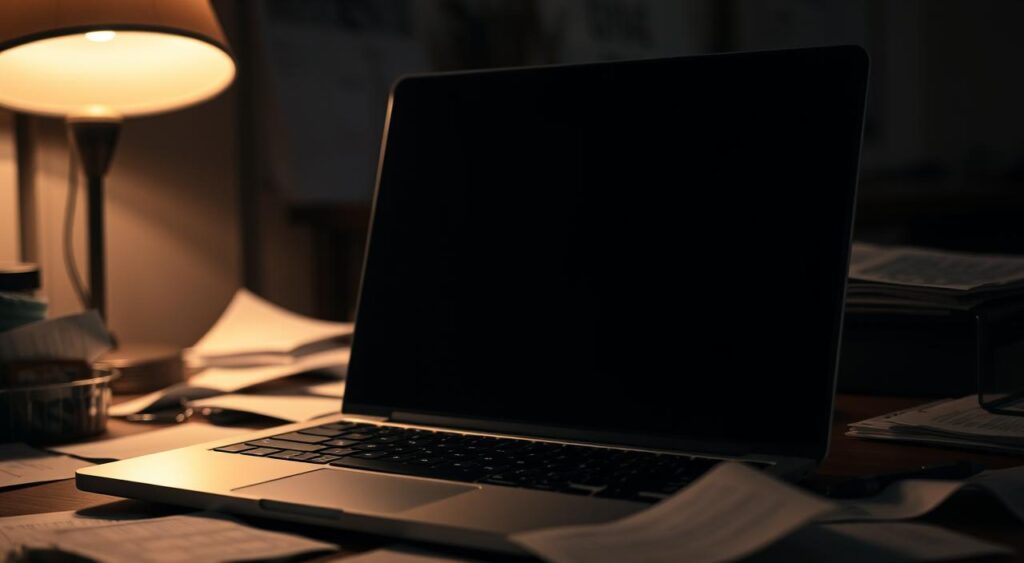Seeing your Laptop Screen Goes Black Randomly can be really frustrating. It stops you from doing important things like video calls, writing, or playing games. Luckily, there are ways to fix this problem, and knowing why it happens can help you solve it faster.
Key Takeaways
- Laptop screen blackouts can be caused by both hardware and software-related issues.
- Common triggers for screen blackouts include overheating, driver conflicts, and power management settings.
- Troubleshooting steps like checking cables, updating drivers, and adjusting power settings can help resolve the problem.
- Hardware problems like faulty display cables, graphics card issues, and screen inverter malfunctions may require professional repair or replacement.
- Software-related solutions, such as reinstalling drivers or performing a system reset, can often address black screen problems.
Understanding Why Laptop Screen Goes Black Randomly
Laptop screens can go black for many reasons, both hardware and software. Knowing what causes these issues is key to fixing them.
Hardware vs. Software Related Issues
There are two main reasons for a laptop screen going black. Hardware problems might include bad display cables, faulty graphics cards, or issues with the screen inverter. Software issues could be driver conflicts, system instability, or compatibility problems.
Common Triggers for Screen Blackouts
Several things can cause laptop display problems. These include:
- Overheating of the laptop’s internal components
- Power issues, like a failing battery or a bad power adapter
- Outdated or incompatible drivers for display, graphics, or other system parts
- Recent software updates or installations that cause problems
Impact on System Performance
When a b, it can really slow down the system. Frequent blackouts can be very frustrating and might cause data loss. They can also lead to other problems like freezing or crashing.
Understanding the causes of random screen blackouts helps users fix their laptops. This ensures their laptops work smoothly and reliably.

Essential Troubleshooting Steps for Black Screen Issues
Seeing a random black screen on your laptop can be really frustrating. But, there are steps you can take to find and fix the problem. By following a step-by-step approach, you can quickly find the cause and get your laptop working again.
First, let’s cover the basics. If your laptop’s screen suddenly goes black, try these quick fixes:
- Check the power supply – Make sure your laptop is plugged in and getting power. If the power light is off, the problem might be with the power source.
- Inspect the display connections – Carefully unplug and plug back in the display cable to ensure it’s connected well.
- Test the display brightness – Try increasing the brightness using the function keys or display settings to see if the screen comes back on.
If these steps don’t work, it’s time to dig deeper. Here are more steps to consider:
- Run a system diagnostic – Use your laptop’s built-in tools or a reliable third-party app to check for hardware or software problems causing the black screen.
- Check for driver updates – Outdated or conflicting display drivers can cause screen blackouts. Update your drivers to the latest version and see if it solves the problem.
- Perform a safe mode boot – Booting in safe mode can help find if the issue is software-related. If the screen works in safe mode, the problem might be with a specific program or setting.
By following these essential steps, you can quickly find and fix the cause of your laptop’s black screen. This will get your device working again in no time.

| Troubleshooting Step | Description | Potential Resolution |
|---|---|---|
| Check power supply | Ensure laptop is properly plugged in and receiving power | Resolve power-related issues |
| Inspect display connections | Unplug and reconnect display cable | Fix loose or faulty cable connections |
| Test display brightness | Increase brightness using function keys or settings | Resolve brightness-related problems |
| Run system diagnostics | Use built-in or third-party tools to check for hardware/software issues | Identify the root cause of the problem |
| Check for driver updates | Update display drivers to the latest version | Fix issues caused by outdated or conflicting drivers |
| Perform safe mode boot | Boot laptop in safe mode to isolate software-related problems | Determine if the issue is software-related |
Common Hardware Problems Causing Screen Blackouts
When your laptop screen goes black, it’s often due to hardware issues. These can include faulty display cables or graphics card failures. These problems can really affect how well your laptop works and what you can do with it.
Faulty Display Cables and Connections
A black screen can be caused by a bad display cable or a loose connection. Over time, these cables can wear out. This can lead to your screen not working right.
Also, if the cable or display port isn’t seated right, you might see a black screen.
Graphics Card Problems
Graphics card issues can also cause a black screen. This includes both built-in and separate graphics cards. Problems with the GPU can show up as a black screen, flickering, or distorted images.
These issues can be due to overheating, damage, or driver problems.
Screen Inverter Issues
The screen inverter is key for your display to work. If it fails, your screen might go black, even if your laptop is on. Inverter problems can be due to old parts, power surges, or electrical issues.
Fixing these hardware problems is key to solving Laptop Screen Goes Black Randomly. Knowing what causes these issues helps you find and fix the problems. This ensures your laptop works well and smoothly.
| Hardware Issue | Symptoms | Potential Causes |
|---|---|---|
| Faulty Display Cables | Intermittent or complete screen blackouts | Wear and tear, physical damage, loose connections |
| Graphics Card Problems | Sudden screen blackouts, flickering, visual distortions | Overheating, physical damage, driver incompatibilities |
| Screen Inverter Issues | Complete screen blackout, even with laptop powered on | Aging components, power surges, electrical issues |
Software and Driver Related Solutions
Fixing software and driver issues can solve random screen blackouts on your laptop. It’s important to keep your operating system and drivers updated. This helps keep your display working well.
Check for any Windows updates or graphics driver updates from your laptop’s website. These updates can help fix problems.
New software or system changes might cause screen blackouts. Uninstall new programs or go back to a previous stable setting. Also, check for malware, as it can affect your display.
Outdated or wrong display drivers can also cause blackouts. Go to your laptop’s support site and get the latest graphics driver. Make sure it matches your laptop and operating system. After installing, restart your laptop and see if the problem is fixed.
FAQ’s
How do you fix a laptop that turns on but has a black screen?
Check the external monitor: Ensure it’s connected properly.
Restart the laptop: Sometimes a simple restart can resolve the issue.
Check the brightness: Adjust the screen brightness using function keys.
Inspect the screen: Look for physical damage or loose cables.
Update drivers: Install the latest display drivers.
Troubleshoot the operating system: Check for software conflicts or corruption.
Why did my laptop screen suddenly go black?
Loose cable: A loose connection to the monitor or power supply can cause a black screen.
Driver issues: Outdated or corrupted display drivers can lead to screen problems.
Hardware failure: A faulty monitor, graphics card, or motherboard can cause a black screen.
Software glitches: Certain software conflicts or bugs can trigger a black screen.
Why does my laptop screen go dark randomly?
Power settings: Check your power settings and ensure that the screen doesn’t automatically dim or turn off.
Software conflicts: Some software programs can interfere with the display.
Hardware issues: A failing graphics card or monitor can cause intermittent blackouts.
Why do I suddenly get a black screen?
Power outage: A sudden power loss can cause the screen to go black.
Monitor cable issue: A loose or damaged monitor cable can disrupt the display.
Software crash: A software crash can lead to a black screen.
Hardware failure: A failing component, like the graphics card or motherboard, can cause a black screen.


